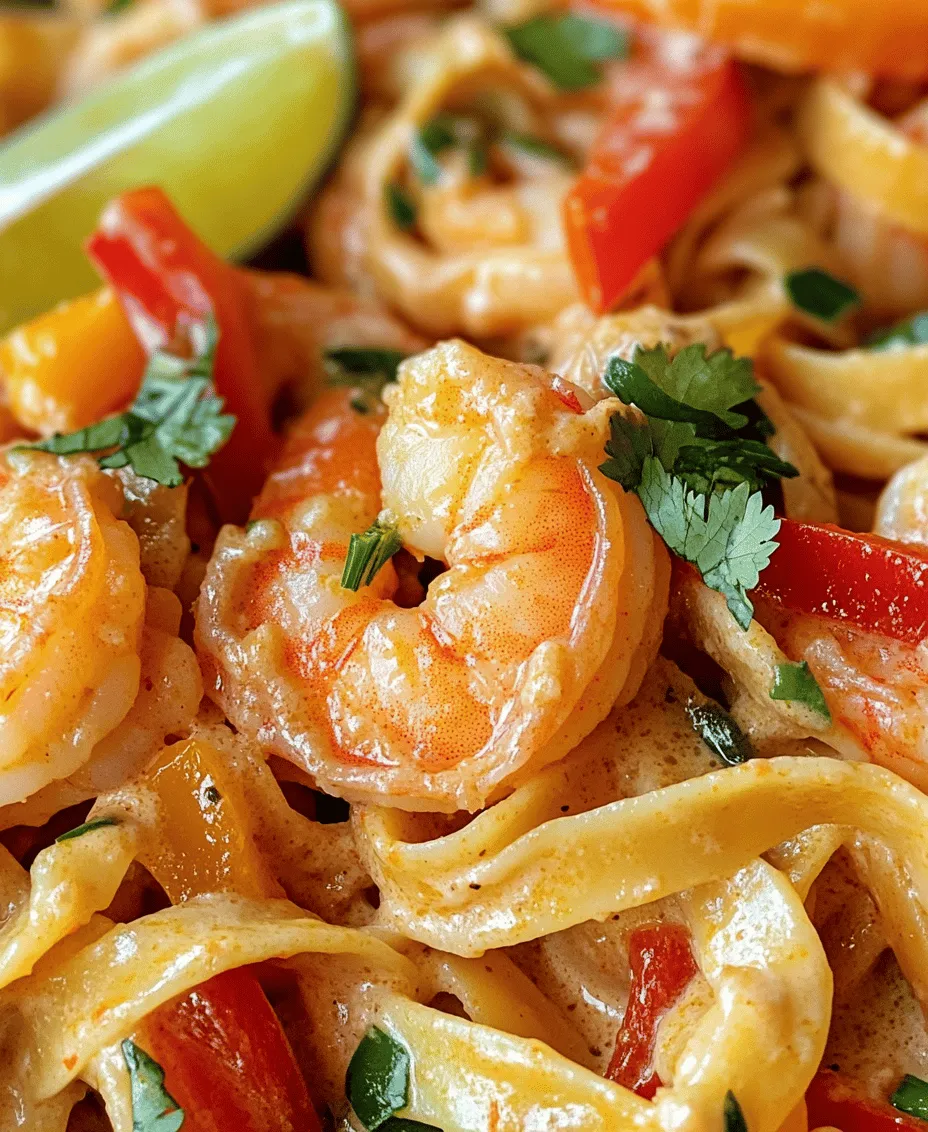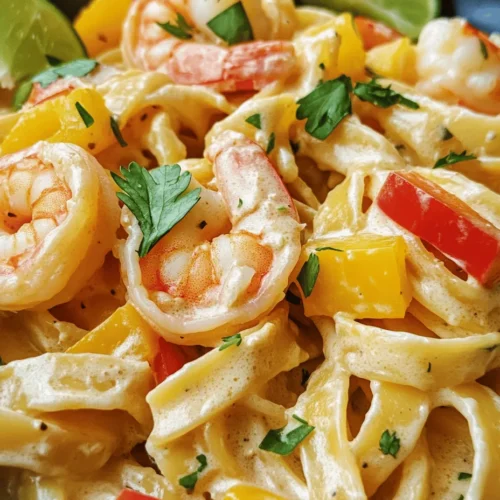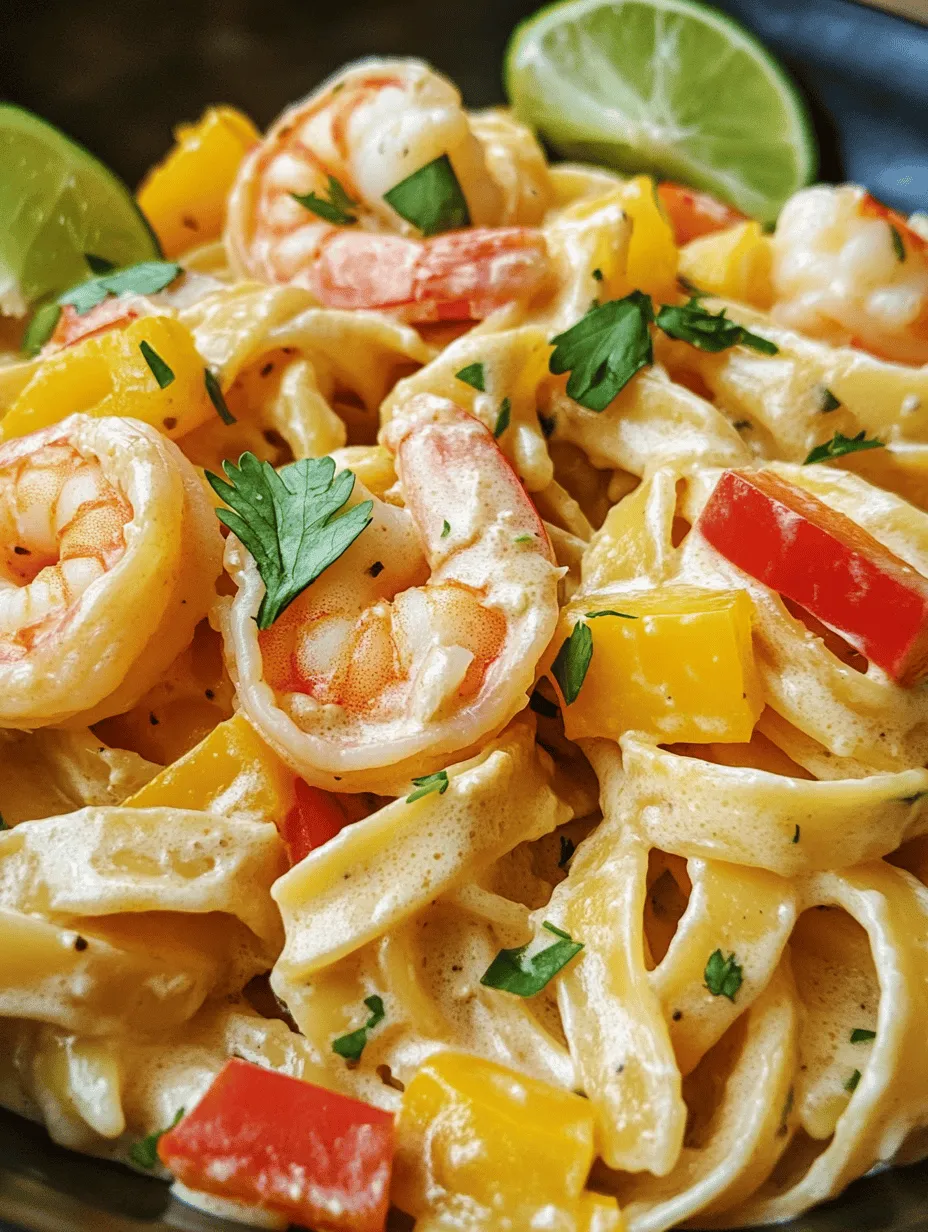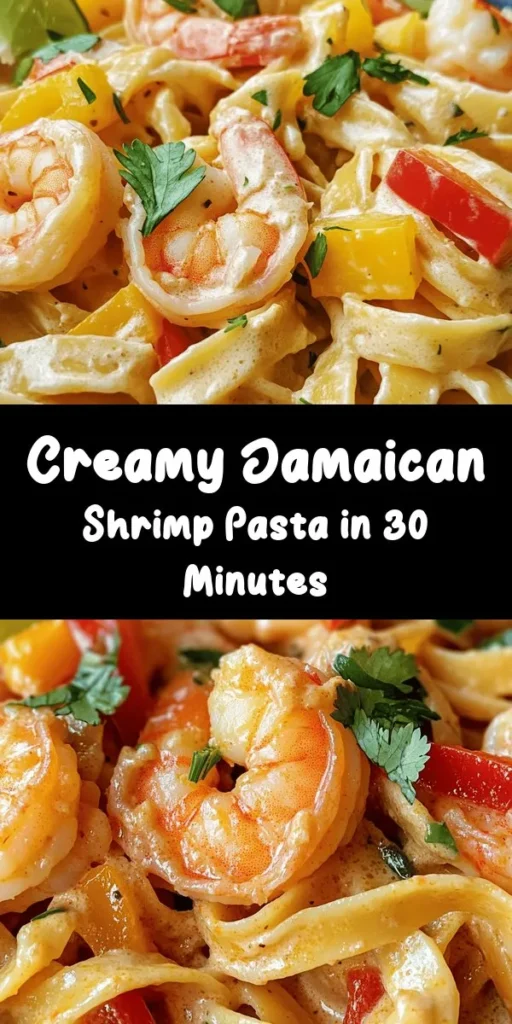Introduction
Jamaican cuisine is a vibrant tapestry of flavors, colors, and aromas that reflect the island’s rich cultural heritage. Known for its bold spices and fresh ingredients, Jamaican food offers a culinary experience that is both comforting and exciting. Among the many delectable dishes that hail from this Caribbean paradise, Jamaican Shrimp Pasta stands out as a unique fusion of traditional Jamaican ingredients and classic Italian pasta. This dish masterfully combines the richness of a creamy sauce with the zest of Caribbean spices, resulting in a dish that is not only flavorful but also easy to prepare.
Imagine a plate of perfectly cooked fettuccine pasta enveloped in a creamy sauce, generously adorned with succulent shrimp and vibrant vegetables. The appeal of Jamaican Shrimp Pasta lies in its ability to transport your taste buds to the sun-soaked shores of Jamaica while providing the comfort and satisfaction of a classic pasta dish. Whether you’re looking for a weeknight dinner option or a dish to impress your guests, this creamy delight is sure to win hearts and appetites alike.
The Allure of Jamaican Cuisine
To truly appreciate Jamaican Shrimp Pasta, it’s essential to understand the key elements that define Jamaican cuisine. At its core, Jamaican food is characterized by its robust use of spices, fresh produce, and a blend of cultural influences. The island’s culinary heritage is a melting pot of African, Spanish, British, and Indian flavors, each contributing to the diverse and vibrant dishes that make Jamaican food so unique.
Spices play a crucial role in Jamaican cooking, transforming simple ingredients into sensational meals. Allspice, known locally as “pimento,” is a staple in many Jamaican dishes, imparting a warm, aromatic flavor that is distinctive and unforgettable. Other spices, such as paprika and cayenne pepper, add depth and heat, creating a harmonious balance that is both exhilarating and satisfying.
Seafood is a cornerstone of Jamaican cuisine, with shrimp being one of the most beloved ingredients. The abundance of fresh seafood along the island’s coastline makes shrimp a popular choice in many households. Rich in protein and low in calories, shrimp is not only delicious but also a nutritious addition to any meal. Its delicate flavor pairs beautifully with a variety of ingredients, making it the perfect star for our Jamaican Shrimp Pasta.
Ingredients Breakdown
Before diving into the cooking process, let’s take a closer look at the key ingredients that make Jamaican Shrimp Pasta a creamy delight.
Fettuccine Pasta
Fettuccine pasta is an excellent choice for this dish due to its wide, flat shape that allows it to hold onto creamy sauces beautifully. When cooked to al dente perfection, fettuccine provides a satisfying bite that complements the richness of the sauce.
Large Shrimp
For this recipe, large shrimp are essential. They not only provide a substantial and meaty texture but also boast a sweet and briny flavor that enhances the overall dish. Packed with protein, shrimp are a healthy addition to your meal, offering essential nutrients such as selenium and vitamin B12.
Olive Oil
The choice of cooking oil can significantly impact the flavor of a dish. Quality olive oil is ideal for sautéing as it imparts a subtle richness and enhances the overall taste. Its health benefits, including heart-healthy fats, make it a staple in both Jamaican and Mediterranean cooking.
Vegetables
The addition of fresh vegetables, such as onions and bell peppers, not only adds color and crunch but also boosts the nutritional value of the dish. Onions provide a sweet base flavor when sautéed, while bell peppers contribute a mild, sweet taste and vibrant hues that bring the dish to life.
Spices
The magical blend of allspice, paprika, and cayenne pepper is what sets Jamaican Shrimp Pasta apart from traditional pasta dishes. Allspice adds warmth and depth, paprika lends a subtle smokiness, and cayenne pepper provides a kick of heat that can be adjusted to suit your taste.
Coconut Milk and Heavy Cream
To achieve that creamy consistency, a combination of coconut milk and heavy cream is used. Coconut milk adds a tropical richness and a hint of sweetness, while heavy cream ensures a luscious, velvety sauce that clings beautifully to the pasta.
Lime Juice
A splash of lime juice at the end of cooking brightens the dish and balances the rich flavors. The acidity from the lime cuts through the creaminess, providing a refreshing zing that elevates each bite.
Fresh Cilantro
Finally, fresh cilantro adds a burst of color and a herbaceous note that complements the dish perfectly. Its unique flavor enhances the overall experience, making every forkful a delightful journey through Jamaican culinary tradition.
Step-by-Step Cooking Instructions
Now that we’ve explored the key ingredients that come together to create this delectable dish, let’s dive into the cooking process. Follow these detailed instructions to prepare Jamaican Shrimp Pasta that will impress your family and friends.
1. Cooking the Pasta
Start by boiling a large pot of water. It is essential to salt the water generously; this is your chance to flavor the pasta as it cooks. Once the water reaches a rolling boil, add the fettuccine and cook according to the package instructions until al dente. The term “al dente” refers to pasta that is firm to the bite, which is crucial for achieving the perfect texture. Overcooking pasta can lead to a mushy result, so keep an eye on the timer.
Once the pasta is cooked to your liking, reserve about a cup of the starchy pasta water, then drain the rest. Set the pasta aside while you prepare the sauce and shrimp.
2. Sautéing the Shrimp
In a large skillet, heat a couple of tablespoons of olive oil over medium-high heat. Once the oil shimmers, add the large shrimp to the pan in a single layer. Cooking them in batches, if necessary, ensures they sear rather than steam. Season the shrimp with salt and pepper, and allow them to cook for about 2-3 minutes on one side until they turn pink and opaque.
Using a spatula, flip the shrimp to cook the other side for an additional 2 minutes. Be cautious not to overcook them, as shrimp can become rubbery if left in the pan for too long. Once perfectly cooked, remove the shrimp from the skillet and set them aside on a plate.
3. Preparing the Vegetables
In the same skillet, add a little more olive oil if needed and toss in the chopped onions and bell peppers. Sauté the vegetables for about 4-5 minutes, or until they are tender and slightly caramelized. This step is crucial for enhancing the flavors of the dish, as the natural sugars in the vegetables develop a lovely sweetness when cooked.
Once the onions are translucent and the bell peppers are softened, it’s time to combine all the elements. Return the cooked shrimp to the skillet, and stir to incorporate them with the sautéed vegetables.
Stay tuned for the next steps, where we will bring together the creamy sauce and complete this delightful Jamaican Shrimp Pasta dish that will surely become a favorite in your household.

Making the Cream Sauce: Techniques for Achieving a Silky Consistency
Creating the perfect creamy sauce for your Jamaican Shrimp Pasta is essential to ensure that each bite is rich and satisfying. The key to achieving a silky consistency lies in the balance of ingredients and cooking techniques.
1. Start with a Base: Begin by sautéing finely chopped onions and garlic in a mixture of olive oil and butter over medium heat. This combination not only adds depth of flavor but also helps create a luxurious texture. Cook until the onions are translucent, but avoid browning them to maintain a fresh taste.
2. Incorporate Coconut Milk: The star of the sauce is coconut milk, which lends a tropical sweetness and creaminess. Pour in the coconut milk gradually, stirring continuously to emulsify it with the oils from the pan. It’s crucial to use full-fat coconut milk for the richest texture. If you’re looking for a lighter version, light coconut milk can be used, but it may not have the same creamy result.
3. Seasoning for Depth: As the coconut milk heats, season the sauce with spices that reflect the essence of Jamaican cuisine. A touch of allspice, nutmeg, and a hint of cayenne pepper can elevate the flavors. To deepen the taste further, add a splash of soy sauce or Worcestershire sauce, which introduces umami notes and enhances the overall profile of the sauce.
4. Thickening the Sauce: If you prefer a thicker sauce, consider mixing a teaspoon of cornstarch with a tablespoon of cold water to create a slurry. Add this to the simmering sauce, stirring until it thickens. This technique ensures a velvety finish without overwhelming the flavors.
5. Finish with Freshness: To brighten the sauce, finish with freshly squeezed lime juice or a sprinkle of fresh herbs like cilantro or parsley just before serving. This adds a refreshing contrast to the creaminess, tying all the elements together beautifully.
Combining Ingredients: The Art of Tossing Pasta with Sauce for Even Coating
Combining your perfectly cooked pasta with the creamy sauce is an art that ensures every strand of pasta is coated and flavorful.
1. Cook the Pasta Al Dente: When boiling your pasta, aim for the al dente texture, which means the pasta should have a slight bite to it. This not only provides a better mouthfeel but also helps the pasta hold up against the creamy sauce.
2. Reserve Pasta Water: Before draining the pasta, make sure to reserve about a cup of the starchy pasta water. This water is a valuable resource for adjusting the consistency of your sauce. The starch helps bind the sauce to the pasta, making each bite cohesive and flavorful.
3. Combine with Care: In a large skillet or pot, add the drained pasta directly to the creamy sauce over low heat. Use tongs or a pasta fork to gently toss the pasta in the sauce. This technique allows the sauce to envelop each strand, ensuring an even coating without breaking the pasta.
4. Adjust Consistency: If the sauce is too thick, gradually add small amounts of the reserved pasta water until you reach your desired consistency. The goal is to create a luscious, creamy dish where the sauce clings to the pasta rather than pooling at the bottom of the plate.
5. Incorporate Shrimp and Vegetables: Finally, gently fold in the sautéed shrimp and any vegetables you have prepared. This step should be done delicately to maintain the integrity of the shrimp and ensure that they don’t become rubbery. Toss just until everything is heated through, and the flavors meld together.
Serving Suggestions: Presentation Tips for a Visually Appealing Dish
The presentation of your Jamaican Shrimp Pasta can elevate the dining experience, making it not just a meal but a feast for the eyes.
1. Choose the Right Plate: Opt for wide, shallow bowls or large, flat plates that allow the pasta to spread out rather than be piled up. This helps in showcasing the vibrant colors of the dish.
2. Garnish with Fresh Ingredients: Adding a touch of freshness can make a big difference. Consider garnishing with a sprinkle of finely chopped cilantro or parsley, which provides a pop of green against the creamy pasta. A wedge of lime on the side can also add a splash of color and a hint of citrus aroma.
3. Add Texture with Crunch: For an added layer of flavor and texture, sprinkle some toasted coconut flakes or crushed nuts (like almonds or cashews) over the top. This not only enhances the visual appeal but also adds a delightful crunch to each bite.
4. Drizzle for Effect: A light drizzle of extra virgin olive oil or a tangy lime vinaigrette over the finished dish can add a glossy sheen, making the pasta look appetizing and inviting.
5. Serve with Style: Don’t forget about your serving utensils. Use attractive serving spoons or tongs that match the aesthetic of your meal. If you’re presenting the dish at a gathering, consider serving family-style with everyone helping themselves, which adds a communal feel to the meal.
Nutritional Information
Understanding the nutritional content of your Jamaican Shrimp Pasta can help you make informed choices while enjoying this delightful dish.
– Calories: Approximately 500-600 calories per serving, depending on portion size and ingredients.
– Protein: Shrimp is an excellent source of lean protein, contributing about 20-25 grams per serving.
– Fats: The dish contains healthy fats primarily from coconut milk, providing around 20-25 grams of fat, with a good balance of saturated and unsaturated fats.
– Carbohydrates: Expect about 60-70 grams of carbohydrates per serving, largely from the pasta.
– Fiber: Incorporating vegetables like bell peppers or spinach can add 3-5 grams of dietary fiber, enhancing digestion and overall health.
Health Benefits of Shrimp and Vegetables
Shrimp is not only delicious but also packed with health benefits. It’s low in calories and high in protein, making it a great choice for those looking to maintain or lose weight. It’s also rich in essential nutrients, including selenium, vitamin B12, and iodine, which are vital for various bodily functions.
Adding vegetables such as bell peppers, spinach, or zucchini not only boosts the nutritional profile but also increases the fiber content, which is essential for digestive health. These vegetables are loaded with vitamins and minerals that support overall well-being.
The Role of Coconut Milk in a Balanced Diet
Coconut milk is a versatile ingredient that brings a creamy texture and unique flavor to dishes. In moderation, it can be a part of a balanced diet due to its healthy fats, particularly medium-chain triglycerides (MCTs), which are known to provide quick energy and may support weight loss. Furthermore, coconut milk contains antioxidants that can help combat inflammation and oxidative stress in the body.
Variations and Customizations
One of the great aspects of Jamaican Shrimp Pasta is its adaptability. Here are some suggestions for variations and customizations:
Dietary Adaptations
– Vegetarian or Vegan Versions: For a plant-based alternative, substitute the shrimp with grilled tofu, tempeh, or even chickpeas. Use a vegan cream alternative, such as cashew cream or a store-bought plant-based cream, to maintain the rich texture of the original dish.
– Seasonal Vegetables: Depending on what’s available, feel free to add seasonal vegetables like asparagus in the spring, cherry tomatoes in the summer, or butternut squash in the fall. These additions not only enhance the flavor but also make the dish visually appealing.
– Alternative Pasta Choices: For those following a gluten-free diet, consider using gluten-free pasta made from rice, quinoa, or lentils. These options provide a similar texture and taste without compromising on flavor.
Pairing Suggestions
Pairing your Jamaican Shrimp Pasta can enhance the dining experience, making it even more enjoyable.
Ideal Beverages
– Wines: A crisp Sauvignon Blanc or a light Pinot Grigio works wonderfully with the creamy sauce and shrimp, enhancing the dish’s tropical notes. If you prefer red wine, a light-bodied Pinot Noir can also be a delightful choice.
– Cocktails: For a refreshing complement, consider serving a mojito or a rum punch. The citrusy and minty flavors will balance the richness of the pasta beautifully.
Suggested Side Dishes
– Salads: A light, fresh salad with mixed greens, avocado, and a tangy vinaigrette can provide a refreshing contrast to the creamy pasta. Consider a mango cucumber salad to tie in tropical flavors.
– Bread: Serve with a side of crusty bread or garlic bread to soak up the delicious sauce. This not only adds texture but also makes for a satisfying meal.
Cultural Significance of the Dish
Jamaican Shrimp Pasta reflects the rich and diverse influences of Caribbean cuisine. The fusion of flavors from African, Spanish, and indigenous Taino cultures creates a unique culinary experience that resonates with many food lovers. The use of coconut, seafood, and spices highlights the availability of local ingredients and the island’s vibrant culinary history.
The increasing popularity of Caribbean-inspired dishes in global cuisine showcases the world’s growing appreciation for these bold flavors. Dishes like Jamaican Shrimp Pasta not only provide a taste of the tropics but also serve as a reminder of the cultural exchanges that have shaped modern cooking.
Conclusion
In summary, Jamaican Shrimp Pasta is more than just a meal; it’s an experience that encapsulates the vibrant flavors and culinary traditions of Jamaica. The combination of creamy coconut sauce, succulent shrimp, and perfectly cooked pasta creates a dish that is both comforting and exotic. With its potential for variations and pairings, this recipe invites creativity and personalization, making it a perfect choice for any occasion.
We encourage you to try this creamy delight and explore the essence of Jamaican cuisine in your own kitchen. With every bite, you’ll be transported to the sun-kissed shores of the Caribbean, enjoying a dish that is not only delicious but also rich in culture and tradition.



